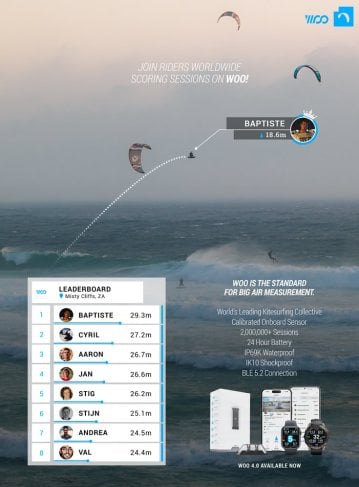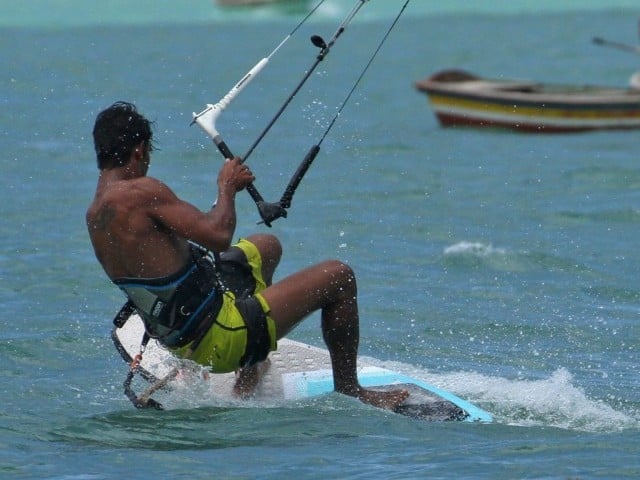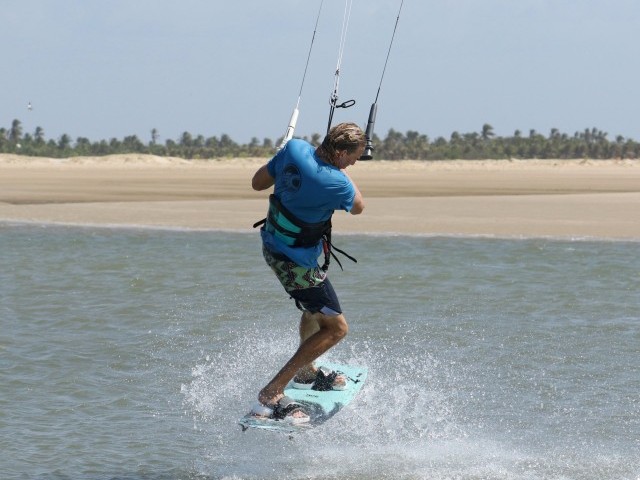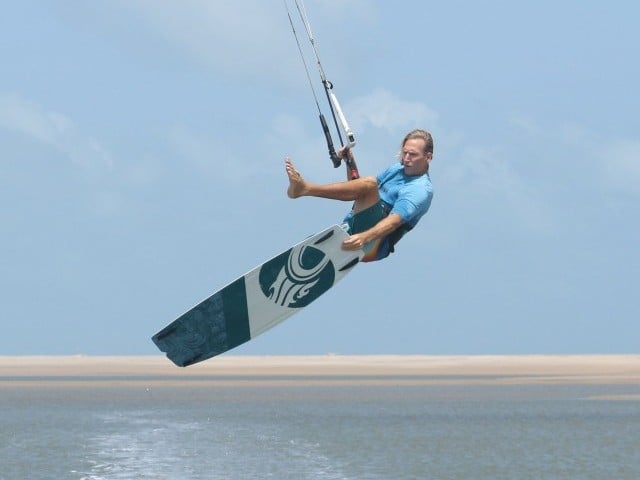
Strapless Hand Plant Back Roll
Technique / Intermediate
This is a lovely surfboard trick that doesn’t require loads of board sticking wind or cat like agility. It’s very much a support move, so if you spend some time on a twin tip and have the back roll hand wash in the bag, with a few tweaks, this could very well be less difficult than you think. Even if you’re not a twin tipper, don’t be discouraged, this hand plant is in the post. We’ve once again enlisted the help of Heliarde to demonstrate in his inimitable style what is needed to see you through to the other side. Without further ado, let’s have a butchers at the separate stages that we’ll piece together to nail this in the box.
The Approach Pic A.
Always a good place to start, the set up here is equally important as any other form of showboating. First rule of thumb for any support move is that you need lift in the kite, and therefore you need tension in the lines. Best to have your sweet spot trimmed out a tad. Approach with your kite at either 11 or 1 o’clock so that you can maintain a good edge and you’ll want some speed too, as this will keep lift in the kite for longer. Your feet want to be comfortably wide enough on the upwind edge of the board, and get your back hand centred on the bar. In Pic A you can see that Heliarde is doing all of the above, as the more lift that he has, the longer the kite will hold him and the more support he’ll have.
Get Down Pic B.
Keeping contact with the board throughout this move is essential. This way it’ll come with you and you’ll have control of it. It’s important that you make contact before you start rotating into your back roll. As such you need to get as low as possible while still keeping an edge. You can see that Heliarde has really squatted down and is reaching down and forwards with his front hand, looking towards the rail of the board just in front of his front foot. At the same time, he has started to drift the kite up slowly towards 12 o’clock. As the kite drifts he keeps the bar on the sweet spot. It’s tempting to let the bar out as the kite drifts and starts to lift, but you want this lift - keep it in.
Plant and Roll Pic C.
This is the crucial moment, get this right and your chances of success are rocketing. Your signal to go is the lift from the kite. As you feel it lift you must start your rotation and look to make contact with the board. You can see that Heliarde has the bar in for support. To start the rotation, he reaches his front hand down, rocking forwards on his front foot whilst lifting his back foot, turning his hips forwards. This movement forwards into the back roll guarantees that he’ll make contact with the board early. It’s easy to throw yourself backwards into this, blindly groping for the board, but if you move forwards you won’t waist any lift and the move will be more controlled and as such more consistent...
Hang & Roll Pic D.
As you feel the board you need to get a good solid push down with your hand or get a grab on the rail. Although Heliarde is grabbing here, it’s not a must, but some form of positive contact is. Now that you have control of the board you can drop your head and shoulders back, which in turn will rock your legs and feet up. With no weight on the board you’ll need all the support you can get from the kite, so hold the bar in on the sweet spot. Now that you’re hanging on the bar, the kite is likely to start drifting a tad quicker. You can see that Heliarde is looking over his back shoulder, just as you would for a back roll, so that he’ll keep rotating.
Hand Axis Pic E.
Your hand is the axis around which you’ll turn. You need to keep it forwards on the board, near where it started, as this will enable you to pull the board along with you and eventually allow you to get back on it! As you rotate around, allow your hand to turn on the board. If you have grabbed the rail, you’ll need to loosen your grip so that you hand can slide onto the deck. You also need to keep yourself up, away from the board and the water, and as long as the kite is still drifting, and you have the bar in you’ll have ample support. As Heliarde comes around, he is leading with his head, so he can see where he is and where the board is. If you throw yourself back into the rotation, you’ll have no idea where you are!
Claim It Pic F.
Now that you’re all the way around, all that’s left is to get yourself back on the board and upright! With your eyes on the target (the board) and the kite supporting you, you can aim to place your feet back on the upwind edge of the board. You can pull your front hand forwards, placing the board under your feet. Keep your knees bent and make sure that your heels grip. As long as they are in place you’ll be fine. As the kite has been drifting and supporting you, it should now be behind you, over at the edge of the window, which means that you can use it to pull you up onto the board. Looking at the picture you can see that Heliarde is very low and his weight is back over the water. From here there is no way that even he can stand up. However now he simply pulls harder on his back hand to loop the kite. With the kite looping around, it pulls him back up as Heliarde rolls forwards onto his feet. Brilliant!
Top Tips
Support is everything, so learning this underpowered on a fast small wave kite will be harder. The bigger the kite the slower it will drift and the simpler this will be.
Start off by trying to get the rotation and plant sorted. If you can get low and then succeed in getting around, then working on getting the feet back on the board should be simple next step. The late kiteloop is the final part of the puzzle, so you shouldn’t worry about it until it’s time.
Hunting out some flat water will make this easier as the board will be happy to come with you.
Now have a look at the sequence and videos....
Common Problems
Not making contact with the board. This really is the number one problem. The reason for this is that in order to be supported and get the feet up you may feel the need to invert, and the natural way to do this is to throw your body back and legs up. As such your front arm is blindly stabbing in the dark, groping for the board. Resist this urge and bend forwards. Concentrate on twisting the hips forwards and lifting the back foot up first. This will ensure contact is made.
Landing on your bum, not your feet. If you’re too low as you come around it means that you have lost support. This could mean that you need to enter with more board speed. However, it’s likely that you have either drifted the kite too quickly or let the bar out and therefore given away tension. Make sure the kite moves slowly and that you keep the bar sheeted in, on the sweet spot.
Keystones
- Enter with good speed on an edge
- Crouch low and drift kite
- Turn hips and plant forwards
- Turn head, feet up and bar in
- Pull board under feet, heels and loop
This technique article was in Issue 72 of IKSURFMAG.
Related
By Christian and Karine
Christian and Karine have been working together as a coaching team, running improver to advanced kitesurfing clinics since 2003.




























